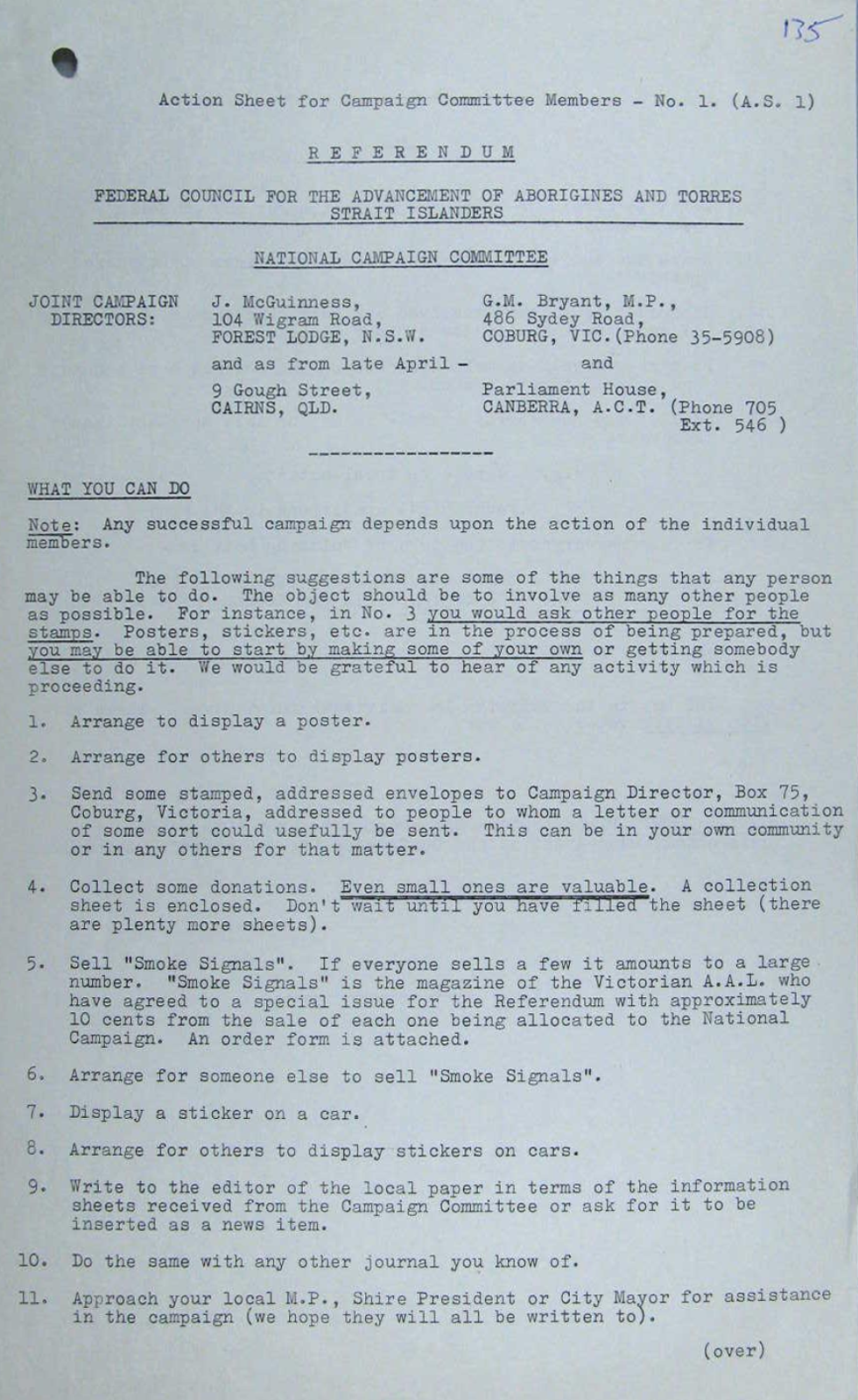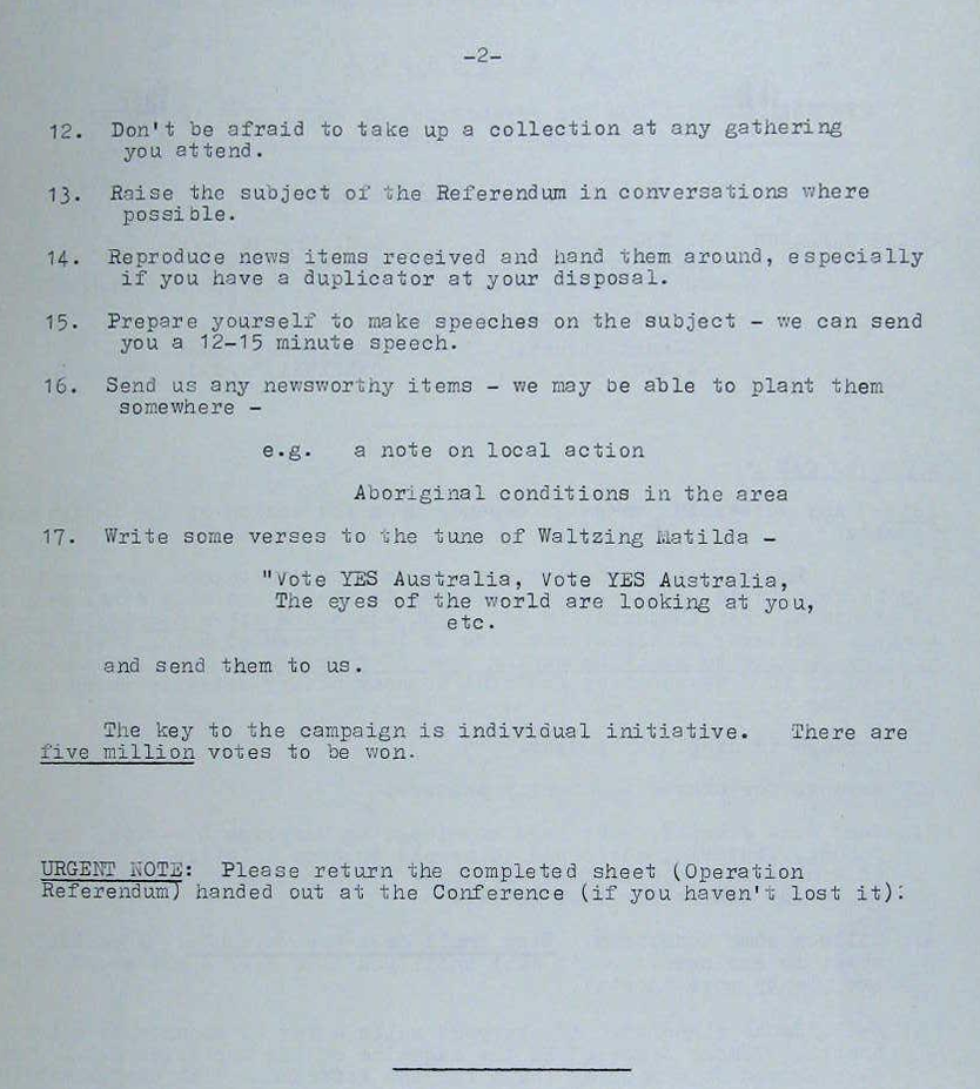

Aboriginal and Torres Strait Islander people should be aware that the National Archives' website and collection contain the names, images and voices of people who have died.
Some records include terms and views that are not appropriate today. They reflect the period in which they were created and are not the views of the National Archives.



[Page 1.]
[Round hole in top left corner.]
[Handwritten number in blue ink:] 135
Action Sheet for Campaign Committee Members – No. 1. (A.S. 1)
[Underlined:] REFERENDUM
FEDERAL COUNCIL FOR THE ADVANCEMENT OF ABORIGINES AND TORRES STRAIT ISLANDERS
[Dividing line.]
[Underlined:] NATIONAL CAMPAIGN COMMITTEE
JOINT CAMPAIGN DIRECTORS:
J. McGuinness, 104 Wigram Road, FOREST LODGE, N.S.W.
and as from late April –
9 Gough Street, CAIRNS, QLD.
and
G.M. Bryant, M.P., 486 Sydney Road, COBURG, VIC. (Phone 35-5908)
[and as from late April –] Parliament House, CANBERRA, A.C.T. (Phone 705 Ext. 546)
[Dashed dividing line.]
[Underlined:] WHAT YOU CAN DO
Note: [word underlined] Any successful campaign depends upon the action of the individual members.
The following suggestions are some of the things that any person may be able to do. The object should be to involve as many other people as possible. For instance, in No. 3 [underlined text:] you would ask other people for the stamps. [end underlined text.] Posters, stickers, etc. are in the process of being prepared, but [underlined text:] you may be able to start by making some of your own [end underlined text] or getting somebody else to do it. We would be grateful to hear of any activity which is proceeding.
1. Arrange to display a poster.
2. Arrange for others to display posters.
3. Send some stamped, addressed envelopes to Campaign Director, Box 75, Coburg, Victoria, addressed to people to whom a letter or communication of some sort could usefully be sent. This can be in your own community or in any others for that matter.
4. Collect some donations. [underlined text:] Even small ones are valuable. [End underlined text.] A collection sheet is enclosed. Don't wait until you have filled the sheet (there are plenty more sheets).
5. Sell "Smoke Signals". If everyone sells a few it amounts to a large number. "Smoke Signals" is the magazine of the Victorian A.A.L. who has agreed to a special issue for the Referendum with approximately 10 cents from the sale of each one being allocated to the National Campaign. An order form is attached.
6. Arrange for someone else to sell "Smoke Signals".
7. Display a sticker on a car.
8. Arrange for others to display stickers on cars.
9. Write to the editor of the local paper in terms of the information sheets received from the Campaign Committee or ask for it to be inserted as a news item.
10. Do the same with any other journal you know of.
11. Approach your local M.P., Shire President or City Mayor for assistance in the campaign (we hope they will all be written to).
(over)
[Page 2.]
[Round hole in top right corner of page.]
-2-
12. Don't be afraid to take up a collection at any gathering you attend.
13. Raise the subject of the Referendum in conversations where possible.
14. Reproduce news items received and hand them around, especially if you have a duplicator at your disposal.
15. Prepare yourself to make speeches on the subject – we can send you a 12-15 minute speech.
16. Send us any newsworthy items – we may be able to plant them somewhere –
e.g. a note on local action[,]
Aboriginal conditions in the area[.]
17. Write some verses to the tune of Waltzing Matilda –
"Vote YES Australia, Vote YES Australia, The eyes of the world are looking at you, etc.
And send them to us.
The key to the campaign is individual initiative. There are five million [number underlined] votes to be won.
[underlined:] URGENT NOTE: [end underlined text] Please return the completed sheet (Operation Referendum) handed out at the Conference (if you haven't lost it).
[Dividing line.]
This record is an action sheet produced by the Federal Council for the Advancement of Aborigines and Torres Strait Islanders (FCAATSI), an organisation that managed a nationwide 'Yes' campaign for the 1967 referendum.
FCAATSI was an organisation formed in the late 1950s to campaign for changes to improve the lives of First Australians. The group had involvement from many influential activists, including Jessie Street, Douglas Nicholls, and Faith Bandler.
A central goal of FCAATSI was to remove words from the Constitution that discriminated against Aboriginal and Torres Strait Islander peoples. This included changing s51(xxvi) so the Australian Parliament could make laws for First Australians. The 1967 referendum represented an opportunity to achieve this goal, which they had been campaigning for since the early 1960s.
This 'action sheet' suggests ways campaign committee members can influence Australian voters in the lead-up to referendum day. Suggested strategies include displaying and distributing posters and stickers, writing to newspapers and journals, approaching members of Parliament, and collecting donations to support the cause.
A key message in this record is the importance of active citizenship. The list of actions concludes with the statement:
'The key to the campaign is individual initiative. There are five million votes to be won.'
The strength of the 'Yes' campaign in 1967 can be seen in the results of the referendum. On 27 May 1967, over 90.77% of voters voted 'Yes'– the highest 'Yes' vote ever recorded in an Australian referendum.
This action sheet suggests that supporters create lyrics to the tune of Waltzing Matilda about voting 'Yes'. Have a go at writing your own lyrics promoting the 'Yes' vote in 1967 and perform it for your class!
Learn how to interpret primary sources, use our collection and more.
